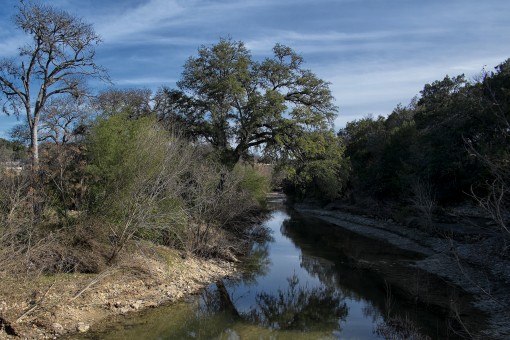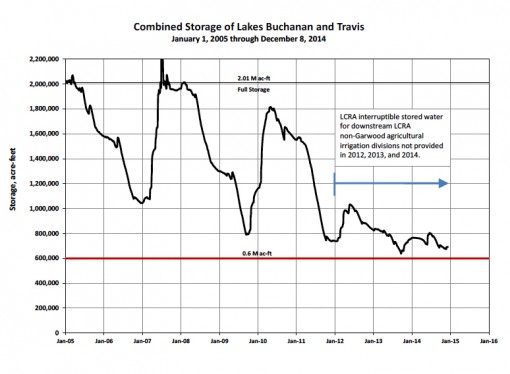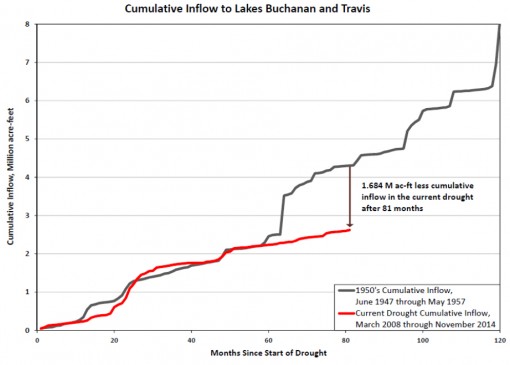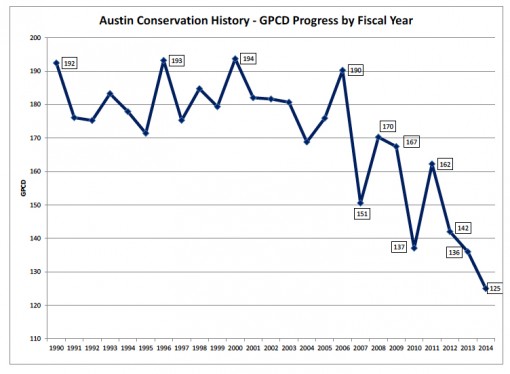Is Too Much Water Going Down the Drain?
January 25, 2015 | By Shoal Creek Conservancy
This blog post was written by Ted Lee Eubanks. To learn more about the author, please visit this site.

The year 2014 has choked to a close. As the cloud of dust settles, let’s see how we fared in this historic drought that still has us in its grasp.
Austin averages 32.15 inches of rain per year. In 2014, we beat the average by 3.38 inches, for a total of 35.53 inches of rain. Sweet! Austin is flush!
The excess didn’t float us out of the drought, however. Lakes Buchanan and Travis have a combined storage of 2 million acre-feet of water. At the beginning of January, 2015, the lakes held less than 700,000 acre-feet, or about 1/3 of full capacity.

Look at the inflows for these two lakes. This next chart compares our current drought with the historic drought of the 1950s. Comparing cumulative inflows 81 months into the droughts, we have received 1.684 million acre-feet less inflow than at this point in the 1950s.

The good news? We are getting better at conserving water. In 1990, Austinites consumed 192 gallons daily per capita. By 2015, this dropped to 125!

The bad news? The population increased at a higher rate than conservation efforts can ameliorate. In 1990, 845,000 people lived in the Austin MSA. By 2014, we grew to 1.7 million people. We may consume less, but there are many more of us consuming.

Cities waste water, and Austin is no exception. Most of our rainfall is quickly shunted to drains, the drains empty into the creeks, the creeks flow to the Colorado River, and the river runs to the Gulf. In other words, we flush most of the rainfall that we receive down the drain.
Shoal Creek is one of the creeks that carries our rainfall away. The creek is an open pipe, rushing storm water to Lady Bird Lake and the Colorado River as fast as its narrow channel will carry it. Yes, we avoid flooding (at least, most of the time). But this approach also denies us the benefits of the little rain we receive.
Most of our rainfall is quickly shunted to drains, the drains empty into the creeks, the creeks flow to the Colorado River, and the river runs to the Gulf…we flush most of the rainfall that we receive down the drain.
There is another approach. In Los Angeles, people are rethinking storm water management. The goal is to create a “sponge city,” one that soaks up rainfall before it gets rushed to the Pacific.
This year the Shoal Creek Conservancy will be wading into the issue of storm water and the creek. Waller Creek has addressed this issue by constructing an immense tunnel to speed its storm water away. There are other options for Shoal Creek, choices that may include not just managing storm water but also saving it.
We have no water to waste, and the SCC is committed to exploring all of the current thinking about better ways to preserve not only the creek, but the precious water that is captured in and flows through its watershed. We will be organizing a Technical Advisory Group (TAG) to help us outline a storm water strategy that we can advocate, and we will be sponsoring a series of lunchtime lectures with storm water experts from around the country to help educate us and the public.
Stay tuned for more information as we move forward in helping Austin better manage our most precious resource – water.
All of the drought charts above are from the most recent Drought Status and Water Supply monthly report from Austin Water.
